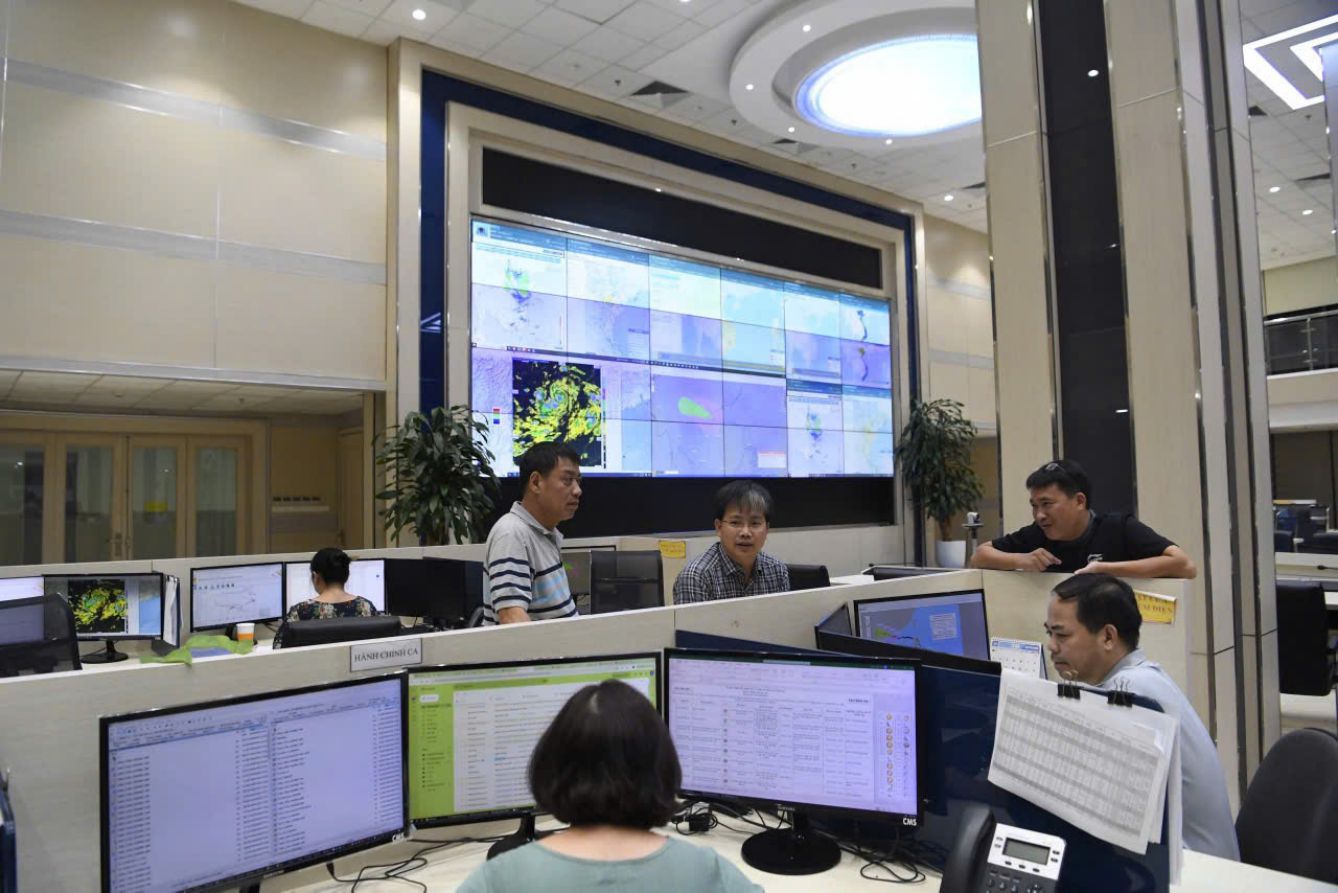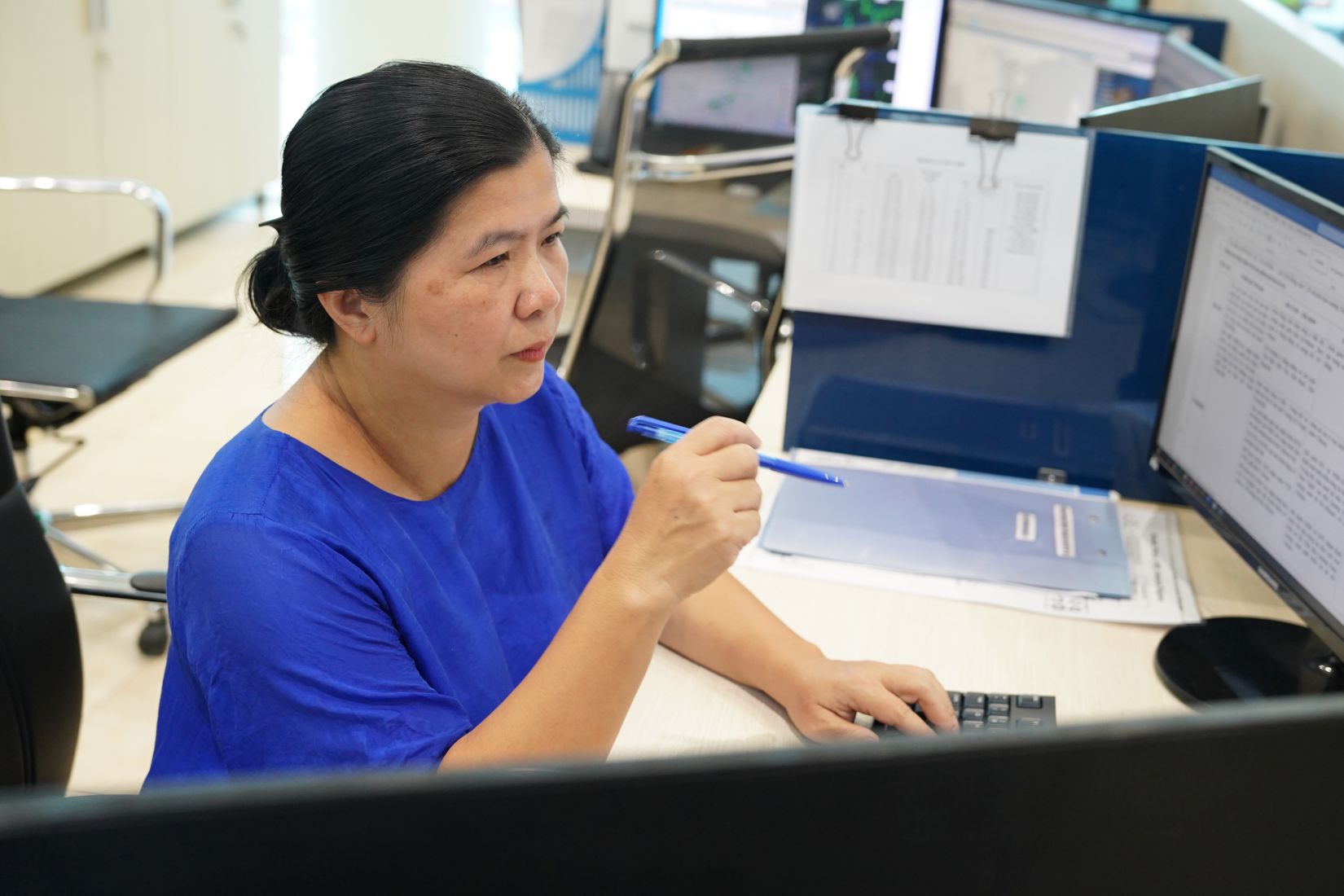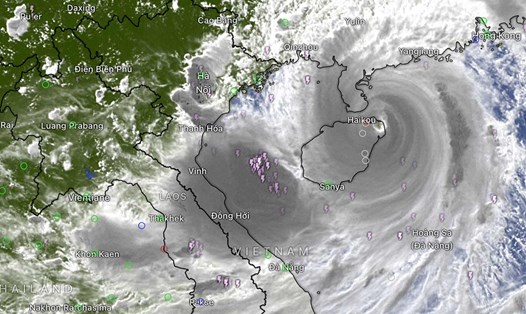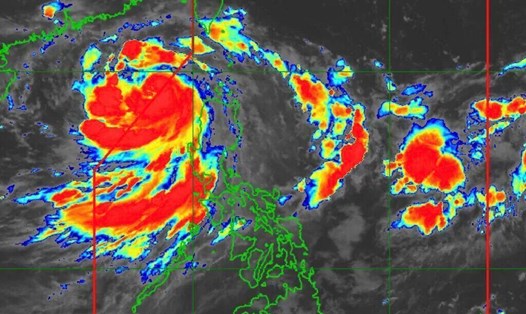Don't dare sleep when the eye of the storm is "still awake"
On September 2, the first bulletin on Typhoon Yagi was issued by the National Hydrometeorological Forecasting Center with worrying scenarios. By the morning of September 3, the storm entered the East Sea at level 8, gusting to level 11, then continuously increasing in intensity - this was also the strongest storm in the past 30 years in the East Sea. On September 5, Yagi became a super typhoon, with the strongest sustained wind speed of 260km/h. On September 7, the storm officially made landfall in our country with fierce intensity.
In those days, the lights at the National Hydro-Meteorological Forecasting Center were always on regardless of day or night. The atmosphere was tense, the central screen displayed a tangle of maps, satellite images of clouds, observation numbers, rainfall, and wind force from everywhere.
In a conversation with our reporter, Ms. Nguyen Thanh Binh - forecaster of the Department of Digital Forecasting and Remote Sensing, National Center for Hydro-Meteorological Forecasting continuously frowned when mentioning the phrase "super typhoon Yagi", the tension started from the first days of realizing the risk of a storm forming.
“My task is to constantly monitor satellite images, taken on 16 spectrum channels, radar images, information from monitoring stations, updated continuously every 10 minutes. Every hour, I have to determine the location of the storm center, the storm intensity because when approaching the shore, every small change of the storm is very important.
The work was repeated from 7pm the night before to 7am the next morning. It was really a series of days of eating and sleeping with the storm" - Ms. Binh stressed.
To provide the most accurate analysis of the storm situation requires alertness, concentration, and seriousness. After working through the night, information about the storm will be quickly compiled into a quick news bulletin on the homepage of the National Center for Hydro-Meteorological Forecasting.
In addition to the flash bulletin, in case of an emergency storm, the Center will provide the fastest updates on the storm's progress every 3 hours. To get that bulletin, it requires the contribution of many different positions.
“Some people will be in charge of writing weather forecasts for the next 3 or 10 days. Some people will be in charge of analyzing maps and operating forecast models. From those locations, they will forecast how much rain, how much wind, what direction it will move, whether it will get stronger or weaker every hour... Therefore, to have the final storm forecast for the people is really a machine that mobilizes a lot of human resources as well as technology,” Ms. Binh confided.

Flood watch - The journey of a hydrologist fighting against storm Yagi
"Never seen before" is the exclamation that many people used to describe Typhoon Yagi during the time the storm raged on land on September 7. The passing of the storm left behind much pain, loss and "horrific haunting". The eye of the storm had left but the remnants remained and at that time the "war" of hydrological forecasters really began.
As the clock struck 1 a.m. on September 9, Nguyen Thi Nhu Quynh, a hydrologist at the National Hydrometeorological Forecasting Center, and her six teammates on the night shift did not leave their computer screens to follow the movements of each number. The rain continued to pour down, the water flow continued to surge, despite the growing anxiety and worry in their hearts.
Suddenly, from outside the door, a voice came in: "Everyone, take turns lying down. This flood will last a long time. If you don't take turns, you won't have the strength." In the left corner of the room, a female forecaster said back: "I can't sleep. The water is rising so fast. If I close my eyes, all I see is numbers."
After 1am, the room still echoed with a panicked voice: "The flow to Thac Ba lake is too high, more than 5000m3/s, and Tuyen Quang lake too, it might exceed the historic flood of 2009, at this rate the lake must release water, the water level downstream will rise to alert level 3, not alert level 2, everything will be flooded". Just like that, the room, which was quiet and still on normal nights, was now torn apart by hurried sounds, panicked sounds, the sound of keyboards clacking mixed with helpless sighs before the raging flood waves.
Hour by hour, Ms. Nhu Quynh and her colleagues held their breath to monitor each value from the electronic monitors. The water level kept jumping from alarm 1, alarm 2, then above alarm 3. Some stations even exceeded historic floods. Never before had the boundary between alarm levels been so fragile.
At 2:30 a.m. on September 9, the seven hydrologists began to “weigh, measure, and count” each value in time for the 3:30 news bulletin. There were two or three options proposed, sometimes only a few tens of centimeters apart. The tug-of-war over each value made them tense as if they were a bowstring, constantly discussing and calculating. The experience and expertise in the profession that seemed to be able to overcome everything was now shaken by the ferocity of nature.
“I have been in this profession for 17 years, but perhaps this is the first time I have checked such a long flood forecast, with so many rivers, so many provinces, so many stations, just lining up in a long line to get into the news.
More than 12 hours have passed, the rain has not shown any signs of abating, the water level is still rushing downstream in all the provinces of the North. Even Hanoi - where the rivers of my hometown are very gentle, suddenly rose fiercely, seeping into every corner of the street, leaving its mark on every wall and roof.
In other provinces and cities, where my colleagues are working, we only have time to report that "the water is very high, everything is flooded". Seeing my colleagues resiliently, overcoming the fierce water, despite the storm and rain, still measuring each water level to promptly transmit data for us to forecast, I am extremely touched, I admire their strong will, the spirit of not giving up, how can I describe that great sacrifice. Without you, we would not be able to complete our mission" - Ms. Nhu Quynh was moved.
The journey to fight against Typhoon Yagi has become a thing of the past, but it is an unforgettable memory for those who work in forecasting. For Mr. Phung Tien Dung - Head of Hydrological Forecasting Department, that memory is the long days and nights fighting with his teammates, struggling with each flood, "weighing, measuring, and counting" each value. That memory is the dark, heavy eyes because of many days without sleep and an empty stomach without feeling hungry. That memory is the sacrifices, hardships, and determination to stay until the end of the teammates on the front line of monitoring.
“In normal storms and floods, we only need to observe the water level on one or a few rivers. However, with Super Typhoon Yagi this time, flooding occurred over a large area, the water level of all rivers rose, at times exceeding the warning level 3.
On all rivers in the Northern region, forces were assigned to be on duty and the duty lasted from September 7 to September 15. It was an extremely stressful week for the forecasters," Mr. Dung recalled.

Happiness is when the storm passes and the sun begins to shine
Typhoon Yagi did not give the officers and forecasters of the National Hydrometeorological Center a moment of rest. With their eyes focused on the eye of the storm, they had to solve the "brain-teasing problems" of the super typhoon that had appeared in Vietnam for the first time in 30 years. Despite the difficulties and hardships, those who work in the "storm-proof" profession have never faltered or regretted pursuing this career.
Working as a forecaster at the National Center for Hydro-Meteorological Forecasting for 25 years, Ms. Nguyen Thanh Binh has experienced many storms. Her overwhelming mood every time the storm season comes is one of stress and anxiety. It is not stress because she will have to work overtime and be tired, but anxiety because each storm season leaves behind too much pain and loss of life and property.
In her story with Lao Dong Newspaper reporter, Ms. Binh also joked: “In our profession, we are not allowed to run into the house during storms,” because when the weather turns bad, she and her colleagues rush to the office. Everyone is aware that the more accurate the forecast information is, the more effective the disaster prevention work will be.
“When the weather turns bad, regardless of day or night, weekday or holiday, we are always ready. Even the room on the 12th floor of the National Hydrometeorological Forecasting Center is always lit 24 hours a day, 7 days a week, 365 days a year,” the female forecaster shared.
Also from the recent landfall of super typhoon Yagi, Ms. Binh remembers typhoon No. 9 Ketsana in 2009 - a storm that left her and her colleagues on duty "breathless".
“The formation and movement of this storm No. 9 is very simple. However, about 12 hours before making landfall, the storm intensified very quickly, the eye of the storm was very round, and the closer it got to the shore, the stronger it became.



With each satellite image received, the eye of the storm seemed to be “staring” at us. At that time, the entire center had to race against time to issue warnings and evacuate people to safe shelters,” Ms. Binh recalled the memories.
As the memories kept flooding back, the female forecaster suddenly paused when asked: “If you could choose again, would you follow this career?” She no longer frowned, nor was she tense, she smiled: “Those memories are the days when I was not with my family during heavy rains and storms. Those memories are also the long sleepless nights, stress, and extreme pressure. However, if I could choose again, I would still follow this career, dedicating all my youth and intelligence to this career, I have never regretted it.”
And the same goes for Mr. Phung Tien Dung - Head of Hydrological Forecasting Department. They are willing to devote their youth and energy to hydrometeorological forecasting. For Mr. Dung, the happiest moments during his 24 years in the profession are when the storms subside, the sun begins to shine, when the river water level recedes even by 1 - 2cm or when there is no longer an urgent flood warning on the rivers.
Storm No. 3 has passed, but the work of meteorologists has not stopped. They are working day and night to provide early forecasts for storm No. 4 and many other dangerous types. And this year, the natural disaster season is forecast to be more severe, but they are always ready to respond, trying their best not to let people be passive in the face of bad weather.
After all, the team working in the hydrometeorology industry is still steadfast, because they believe:
“Tomorrow the sky will be bright again The silt will again bring nutrients to the flowers.”
Dr. Hoang Duc Cuong, Deputy Director of the Directorate of Hydrometeorology (Ministry of Natural Resources and Environment), said that early warning is very important in preventing and responding to natural disasters. "Therefore, the slogan of early warning for early action has become the motto of the Hydrometeorology sector up to now, not only in specific natural disaster situations but throughout all days of the year," said Mr. Cuong.









